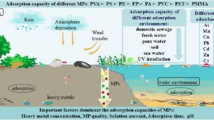Abstract
Experiments were carried out under various pH conditions since this factor may strongly influence the equilibrium of various physico-chemical forms in which a certain trace element may occur in the aquatic environment. Pick-up processes were investigated for iron, cobalt, zinc, ruthenium and mercury under various experimental conditions. The rate and type of bonding or association of trace metals in humic acids was investigated by means of their replacement with other ions. For this reason the pick-up of a radionuclide of a certain trace metal by humic acid was performed, and when equilibrium was reached, the humic acids were transferred to another system where a known concentration of another ion was present. Replacement reactions took place and their yields were followed by radioactivity measurements in the liquid phase. The shape of each curve indicates the specific kinetics of the interaction of a particular trace element with humic acids under experimental conditions. Speed, total yield and time needed to reach equilibrium are specific for each particular case. The purpose of our work is to investigate the nature of trace-element interactions with humic acids. Having in mind the large variations that may occur in the constitution of humic acids, our attention focussed primarily on the search for the role these chemical variations and the different processes of their formation play on the ability of humic acids to bind trace elements.
Our results demonstrated that charge-dependent processes, such as ion exchange and sorption-desorption, present a major interaction mechanism in humic acidtrace element interaction. Another important mechanism by which some trace elements are associated with humic acids seems to be chelation.
Similar content being viewed by others
Literature Cited
Clark, F. E. and K. H. Tan: Identification of a polysaccharide ester linkage in humic acid. Soil Biol. Biochem. 1, 75–81 (1969)
Cheng, K. L.: Separation of humic acid with XAD resins. Microchim. Acta (Wien) 2, 389–396 (1977)
Desai, M. V. M. and A. K. Ganguly: Interaction of trace elements with the organic constitutents in the marine environment. Report BARC-488, Bombay 1970
Felbeck, G. T. Jr.: Structural chemistry of soil humic substances. Adv. Agron. 17, 327–369 (1965)
Huljev, D. and P. Strohal: Neutron activation analysis for studying the role of humic acids during transport of trace elements in the marine biocycle. Proc. Symp. on Nuclear Activation Techniques in the Life Sciences, IAEA, Vienna, pp 385–390, 1972
Kononova, M. M.: Soil organic matter, 544 pp. London, New York: Pergamon Press 1966
Koshy, E. and A. K. Ganguly: Organic materials in the marine environments and their interactions with some metal ions. Report BARC-402, Bombay 1969
Kukharenko, T. A. and A. A. Saveleva: Hydrogenation of humic acids in the presence of a nickel catalyst. Dokl. Akad. Nauk. S.S.S.R. 76, 77–80 (1951)
Manskaya, S. M. and T. V. Drozdova: Geochemistry of organic substances, 345 pp. London, New York: Pergamon Press 1968
Montoura, R. F. C. and J. P. Riley: The analytical concentration of humic substances from natural waters. Anal. chim. Acta 76, 97–106 (1975)
Rashid, M. A. and L. H. King: Major oxygen-containing functional groups present in humic and fulvic acid fractions isolated from contrasting marine environments. Geochim. Cosmochim. Acta 34, 193–202 (1970)
Rona, E., D. W. Hood, L. Muse and B. Buglio: Activation analysis of manganese and zinc in sea water. Limnol. Oceanogr. 7, 201–206 (1962)
Slowey, J. F., L. M. Jeffrey and D. W. Hood: Evidence for organic complexed copper in sea water. Nature, Lond. 214, 377–378 (1967)
Strohal, P. and D. Huljev: Investigation of mercury pollutant interaction with humic acids by means of radiotracers. Proc. Symp. on Nuclear Techniques in Environmental Studies, IAEA, Vienna, pp 439–446, 1971
Stuermer, D. H. and G. R. Harvey: The isolation of humic substances and alcohol soluble organic matter from seawater. Deep-Sea Res. 24, 303–309 (1977)
Tan, K. H.: Contamination of humic acid by silica gel and sodium bicarbonate. Plant Soil 44, 691–695 (1976)
Wershaw, R. L., D. J. Pinckney and S. E. Booker: Chemical structure of humic acids—Part 1, A generalized structural model. U.S. Geol. Survey. J. Res. 5, 565–569 (1977)
Wershaw, R. L. and D. J. Pinckney: Methylation of humic acid fractions. Science, N.Y. 199, 906–907 (1978)
Author information
Authors and Affiliations
Additional information
Communicated by B. Battaglia, Padova
Rights and permissions
About this article
Cite this article
Huljev, D., Strohal, P. Physico-chemical processes of humic acid-trace element interactions. Mar. Biol. 73, 243–246 (1983). https://doi.org/10.1007/BF00392249
Accepted:
Issue Date:
DOI: https://doi.org/10.1007/BF00392249




